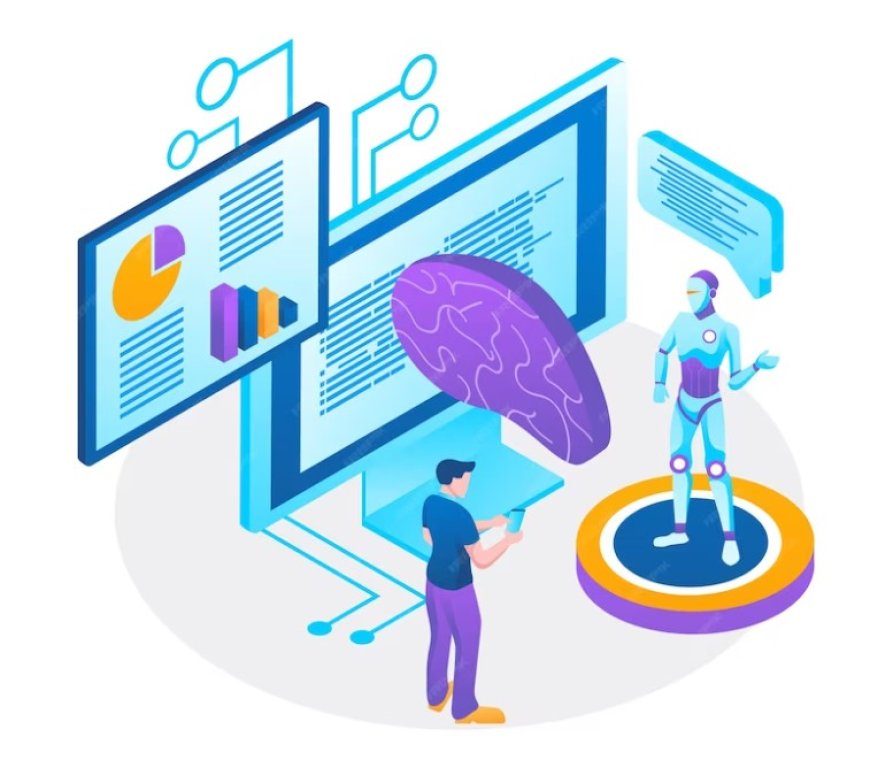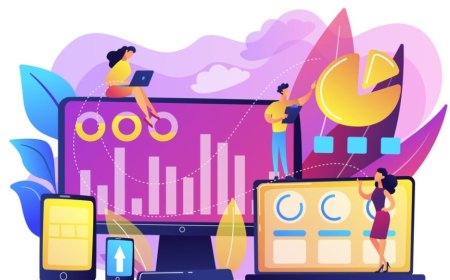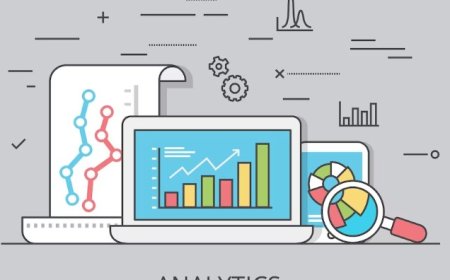The Future of Data Analytics: AI and Machine Learning Trends
Discover the future of data analytics with insights into AI and machine learning trends. Stay ahead in the evolving data landscape.

Data analytics is like the detective work of the digital world. It's all about collecting and studying data to find patterns and make sense of it. Think of it as sorting through clues to solve a mystery. In today's world, we're swimming in data. Every click on a website, every purchase, every post on social media – it's all data. And businesses use this data to make important decisions. They want to know what their customers like, what products are selling, and how to improve their services. Data analytics is the tool that helps them do it.
Data is like a compass for decision-making. Just as a GPS helps you navigate, data helps businesses find their way. When they have the right data, they can make informed choices. For example, if a restaurant sees that a particular dish is a hit, they'll offer it more often. If a company knows which ads customers respond to, they can use their marketing budget wisely. It's all about making decisions based on facts, not guesses.
AI and machine learning are like supercharged detectives in the data analytics world. They can analyze massive amounts of data faster and smarter than humans. They're like the secret sauce that makes data analytics even more powerful. As the digital world keeps growing, so does the amount of data. That's where AI and machine learning come in handy. They help businesses dig deeper into data, find hidden insights, and predict future trends. It's like having a crystal ball to see what's coming next in the business world. This is why they're becoming more and more important in data analytics.
Challenges and Limitations in Traditional Data Analytics:
Traditional data analytics, in simple terms, is like using a flashlight to understand a complex puzzle. It has its limitations. One big challenge is that it can handle only a fraction of the data we generate daily. It's like trying to sip water from a firehose! This means that we often miss valuable insights hidden in mountains of data.
Another limitation is that traditional analytics mostly tell us what happened in the past. It's like looking in a rear-view mirror. We need more than that. We need to know what might happen in the future and what to do about it. This is where predictive and prescriptive insights come in. They're like a GPS for your data, helping you see what's ahead and guiding you on the best path.
The Growing Volume of Data and the Need for More Efficient Analysis:
Think of data like puzzle pieces. Every day, we're adding more pieces to the puzzle, and it's becoming a massive jigsaw. Traditional analytics can only handle a few pieces at a time. With the explosion of data from the internet, sensors, and devices, it's like trying to solve a giant puzzle in a tiny room. We need bigger, smarter rooms, which is where AI and machine learning come in.
These growing mountains of data also mean we need faster and more efficient ways to make sense of it. It's like needing a speedier puzzle-solving technique because the puzzle keeps getting bigger. AI and machine learning can do this by quickly identifying patterns and insights that would take humans forever to find.
The Need for Predictive and Prescriptive Insights in Addition to Descriptive Analytics
Descriptive analytics is like telling the story of the puzzle after it's completed. It's interesting but not always helpful for the next puzzle. We need more. Predictive insights are like having a crystal ball that suggests what the next puzzle will look like. Prescriptive insights then tell you what to do to solve it, just like a puzzle-solving guide.
Imagine you're a detective. Descriptive analytics tells you what happened at the crime scene, but predictive analytics helps you anticipate where the next crime might occur. Prescriptive analytics then gives you a plan on how to prevent it. It's like having a detective's superpower.
What's Up-and-Coming in AI and Machine Learning for Data Analytics?
AI and machine learning are like the cool kids on the block when it comes to data analytics. They're the secret sauce behind understanding and making sense of all the data that's out there. But what's new in this world of algorithms and data crunching? Let's dive in and explore some emerging trends without getting lost in the tech jargon.
Deep Learning: Think of deep learning as a super-smart detective. It's all about teaching computers to learn and make decisions by themselves, just like Sherlock Holmes. Deep learning algorithms are like those magnifying glasses that help computers analyze large amounts of data, identify patterns, and even understand images and speech. This trend is making AI more capable and smarter than ever.
Natural Language Processing (NLP): NLP is like a language guru for computers. It helps them understand and work with human language, just like a polyglot who can speak many languages. Thanks to NLP, machines can now read, comprehend, and respond to text or speech. This is incredibly handy for things like chatbots, language translation, and sentiment analysis in customer feedback.
Reinforcement Learning: Reinforcement learning is like training a pet. Computers learn by trial and error, and they get better at tasks as they keep trying. This trend is perfect for tasks that require decision-making, like robotics, game playing, and autonomous vehicles. It's like teaching a robot how to ride a bike by letting it try and not giving up when it falls.
Explainable AI: Imagine AI as a magic box that makes decisions, but you have no idea how it came up with the answers. Explainable AI is like opening that box and understanding the wizardry inside. It's all about making AI transparent, so we can trust its decisions, especially in critical areas like healthcare and finance.
Edge AI: Edge AI is like having a mini-computer right in your pocket. It's all about doing AI magic on your device, like your smartphone or a security camera, instead of sending everything to a big data center. This trend makes real-time data analysis possible, like recognizing your face for phone unlocking.
AutoML (Automated Machine Learning): AutoML is like the easy button for machine learning. It's all about creating tools that make it simple for non-techies to use machine learning. With AutoML, you don't need to be a data scientist to harness the power of AI for your business. It's like making AI accessible to everyone.
So, what does all this mean for the future?
These trends are transforming how we use data. They are making AI smarter, more understandable, and accessible. It's like having a personal assistant that understands you better, communicates in your language, learns from experience, and does all this right on your device.
How will these trends address the challenges in traditional analytics?
Traditional analytics, like old-school detectives, focused on past data to solve mysteries. But, as the world sped up, traditional methods started struggling. Imagine using a flip phone in the age of smartphones. It's time to upgrade! Here's how the new trends in AI and machine learning will tackle these challenges in simple terms.
-
Speed and Efficiency: Traditional analytics can be slow, like a turtle. AI and machine learning are more like cheetahs. They can analyze massive amounts of data in a flash. So, you get insights faster, helping you make quicker decisions.
-
Dealing with Big Data: Traditional analytics often got overwhelmed by mountains of data. AI and machine learning can handle data mountains. They can find hidden patterns and insights, even in this data chaos.
-
Predicting the Future: Traditional analytics can tell you what happened in the past, like a history book. AI and machine learning can predict the future. They use patterns from the past to tell you what's likely to happen next. It's like having a crystal ball for your business.
-
Understanding Unstructured Data: Traditional analytics likes data neatly organized in tables. But in the real world, data comes in all shapes and sizes - text, voice, images, you name it. AI and machine learning can make sense of this unstructured data. It's like having a translator for data in different languages.
-
Learning and Adapting: Traditional analytics can be rigid, like a fixed recipe. But AI and machine learning are more like a chef who can tweak the recipe as they go. They learn and adapt from new data, making their insights more accurate over time.
-
Explainable Insights: Traditional analytics can be a black box. You put data in, and you get results, but you might not know why. AI and machine learning aim to be transparent. They'll show their work, like a math teacher explaining a problem step by step.
-
Real-time Decision Support: Traditional analytics often worked on a delay. AI and machine learning can provide real-time insights. It's like having a GPS that updates you on traffic conditions as you drive, so you can choose the fastest route.
-
Democratizing Data Analysis: Traditional analytics required experts, like professional chefs. AI and machine learning aim to be more like a microwave - accessible to more people. AutoML, for instance, simplifies the process, making data analysis easier for everyone.
-
Personalization: Traditional analytics treated everyone the same. AI and machine learning can create personalized experiences. It's like having a store that knows your preferences and shows you things you're interested in.
-
Ethical Considerations: As AI and machine learning get more powerful, we need to be mindful of how they're used. Just like we follow rules in games, there should be ethical guidelines to ensure fairness, privacy, and security in data analysis.
Impact on Various Industries and Decision-Making Processes:
The future of data analytics, powered by AI and machine learning, is like a magic wand that's set to transform industries and how decisions are made. Let's take a closer look at the impact of these trends on different sectors and decision-making processes.
In healthcare, these trends are helping doctors make faster and more accurate diagnoses, improving patient care. In finance, AI is crunching big data to predict market trends and reduce financial risks. Marketing is getting smarter, targeting ads to the right people at the right time.
But it's not just industries benefiting. These technologies are affecting decision-making at all levels. From business leaders who use AI to optimize operations and boost profits to everyday choices like what movies to watch on streaming platforms, AI and machine learning are making life easier and more tailored to our preferences.
These trends also have an impact on how we interact with technology. Think about voice assistants like Siri or Alexa; they're powered by AI, and they're making our lives more convenient by understanding and responding to our voice commands.
The future is exciting, but it's not without challenges. We need to ensure these technologies are used ethically and responsibly, protecting privacy and avoiding bias in decision-making processes. The impact is profound, and as AI and machine learning continue to evolve, they'll shape the way we live and work.
The future of data analytics is looking bright with AI and machine learning leading the way. These technologies are making data analysis smarter, faster, and more useful. They're helping businesses and decision-makers make better choices. But, we must also be mindful of how we use these powerful tools and ensure we use them ethically. As we embrace these trends, we're opening doors to a world where data isn't just numbers; it's a valuable friend that guides us towards smarter decisions and a brighter future.




























































